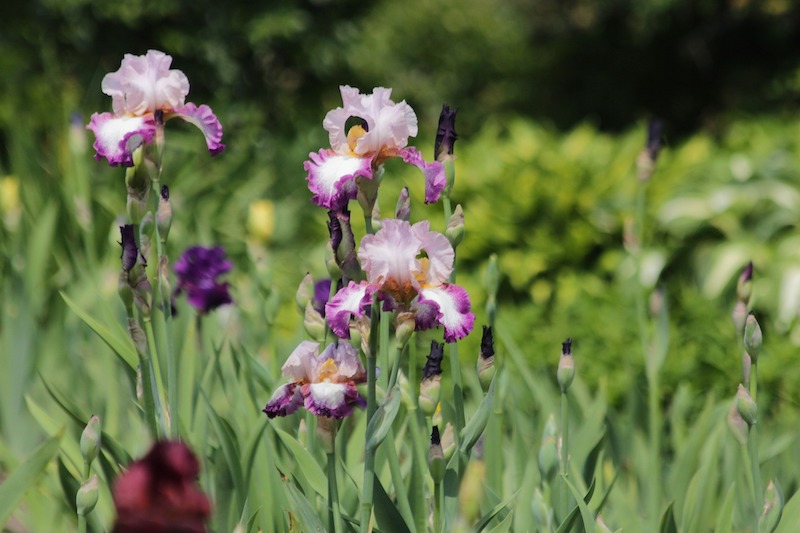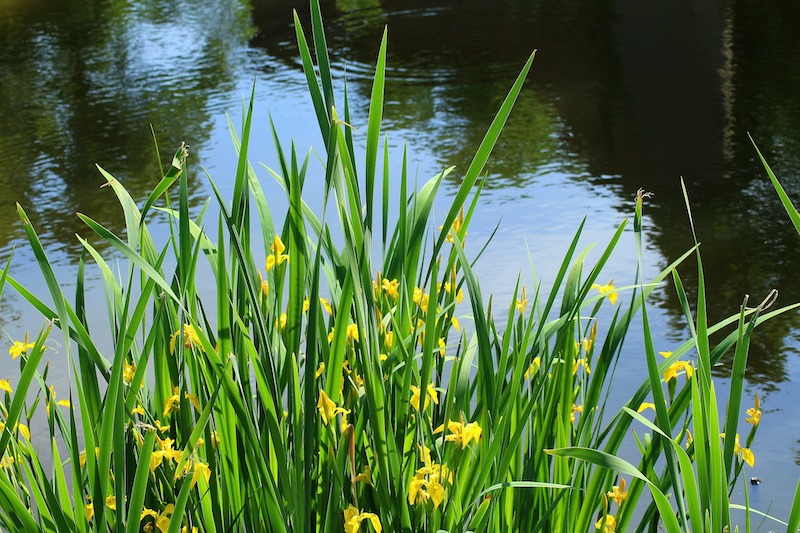Irises grow from rhizomes or bulbs and can be broadly divided into three types for garden cultivation: bearded, beardless, and bulbous. Knowing the type determines what type of soil, moisture content, and even sun exposure are ideal for a thriving plant. Iris germanica (bearded irises) have thick rhizomes that store all of the energy for the plants during the winter dormancy period. Most of the bearded varieties have origins in central and southern Europe and tolerate drought conditions easily.

The bulbous irises, which includes Iris hollandica (Dutch hybrid iris), are bulbs that are planted in the fall and grown in the same manner as other spring bloomers such as daffodils or tulips. The beardless group of irises have dense, fibrous roots that can tolerate damp conditions but will also easily handle short periods of drought. Iris siberica, Siberian iris, and Iris ensata, Japanese iris, form dense clumps of grass-like foliage that remain neat and tidy all summer making it a great backdrop for other perennials and shrubs.
What You Need To Plant Iris
- Transplanting shovel or another small-headed spade
- Finely shredded organic material for mulching the root zone
- Location with at least 6 hours of full sun exposure
- Well-draining soil
- Water source
- Pond plant pots (if planting in a pond)
- Potting mix for pond plants (if planting in a pond)
- Sharp gravel or pea gravel (if planting in a pond)
Where To Plant Iris
All types of iris will bloom best when given 6 hours or more of full sun. Shade early or late in the day is acceptable and even preferable in the warmest growing zones. The beardless types of iris will tolerate partial shade while still blooming well. Bearded irises crave the baking hot sun of a southern or western exposure. In fact, the rhizomes themselves should be planted so that they are slightly above the ground and in full view of the sun. Beardless varieties including Iris versicolor, the North American native Blue Flag Iris, and Iris pseudacorus, Yellow Flag Iris, which is nonnative and invasive in most states, make themselves at home in a pond or other damp garden in full sun.

Dutch Hybrid bulbs are versatile enough for planting in the garden alongside other perennials and shrubs or in a container as a single variety planting. Plant these bulbs twice as deep as their overall size.
Iris Spacing
Irises are fairly rapid growers that will need regular dividing to maintain vigorous growth. The bulb-type iris can be planted as close as 4-6 inches apart in the ground. This will allow the plants room to grow for a few years before needing to be divided. Bearded and non-bearded irises should be spaced at least 12 inches apart. These irises will grow fine planted closer together but will need to be divided much more often to maintain blooming and reduce the risks of pests and diseases. Siberian iris and Japanese iris should be planted like any other fibrous perennial. Depending on the overall size, space the plants 18-24 inches apart on the center of each plant.
Steps To Plant Iris
Step 1 - Amend heavy or poorly draining soil. Mix in 1-2 inches of organic compost in the planting area.
Step 2 - Water pot-grown plants well the night before planting to lessen transplant shock for the iris.
Step 3 - Dig a shallow hole that is twice as wide as the container the plant is growing in.
Step 4 - Orient the plant so the thick rhizomes are in full view of the sun with one-third of the top of the rhizome above the soil level.
Step 5 - Gently backfill the soil around the iris rhizome and firm it in well.
Step 6 - Water thoroughly around the root zone before applying a 3-4-inch layer of mulch to suppress weeds and help the soil retain moisture longer.
Step 7 - Bulbous irises should be planted in the fall so that they have a period of chilling before the first growing season. Plant the bulbs twice as deep as their diameter and proceed with step 5.
Step 8 - Nonbearded irises can be planted at any time of the year and should be treated like other herbaceous perennials. Dig a hole as deep and twice as wide as the root mass. Position the root ball of the plant so the growing crown is level with the surface of the soil. Proceed with step 5.
Step 9 - Irises that will be growing in a pond will need to be planted in a pond plant basket with the appropriate pond potting mix. Place a thick layer of pea gravel or other gravel on top of the planting mix. This helps weigh down the pot and hold the soil in as the pot is lowered into the pond. Planting in pond pots is the best way to keep Iris pseudacorus under control.
When To Plant Iris
Dutch hybrid iris needs to be planted in the fall so it will experience a period of cold. Bearded types can also be planted in the fall, although spring dividing and planting are also successful. Nonbearded types are best planted in the spring with other perennial plants.

Transplanting Iris
Divide any type of iris when the plant begins to lose growing vigor or flowering declines. Transplanting and dividing of all iris types is best done in the spring after new growth has begun. Dig up the whole clump for the rhizome type of iris, and look for the divisions between rhizomes. Gently tease the rhizomes apart and replant each division at the same depth it was growing in. Cut any foliage back by half in a fan shape. This helps the plant recover and grow new roots quicker.
 |
Author Robbin Small - Published 4-18-2023 |
